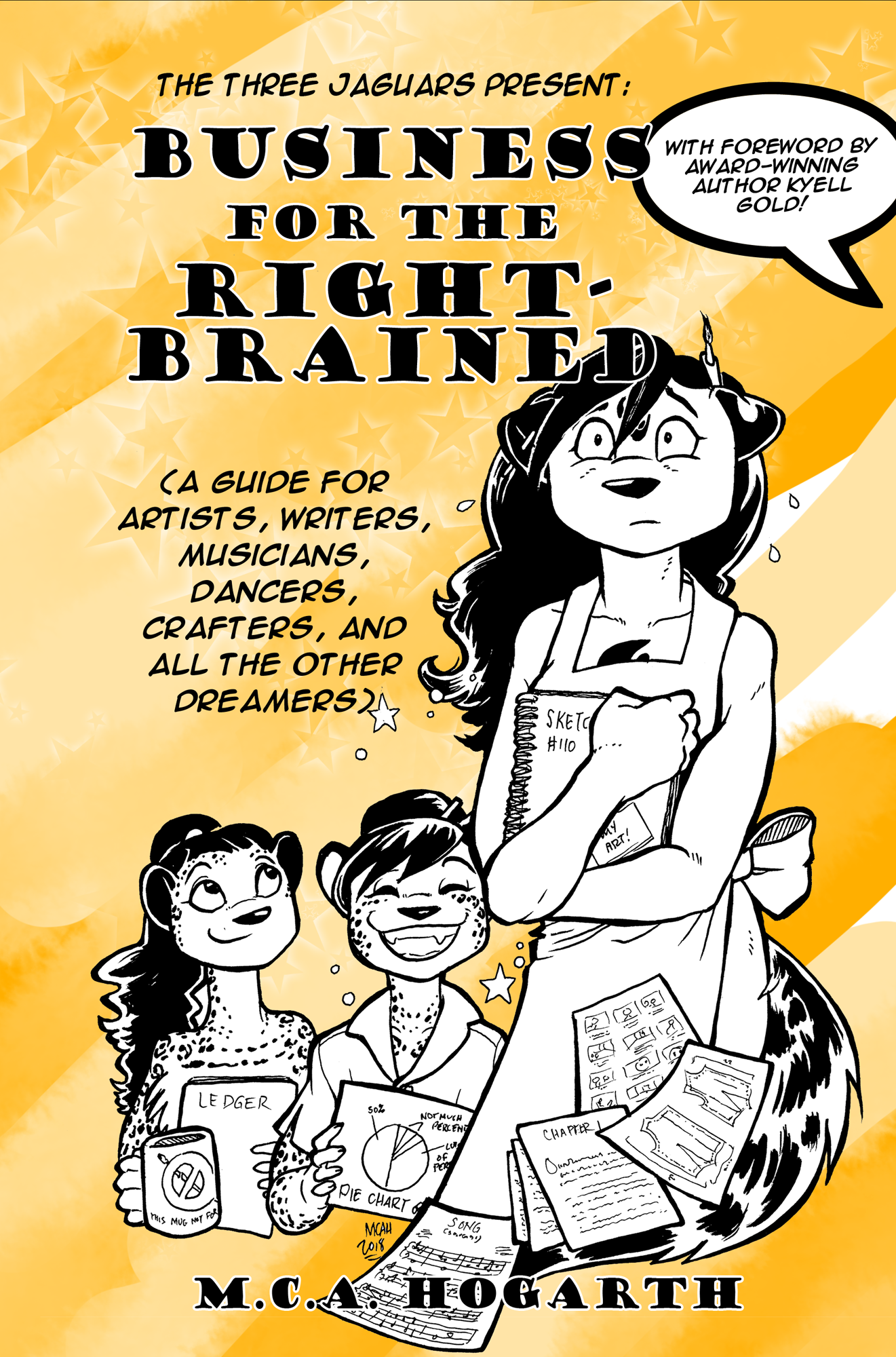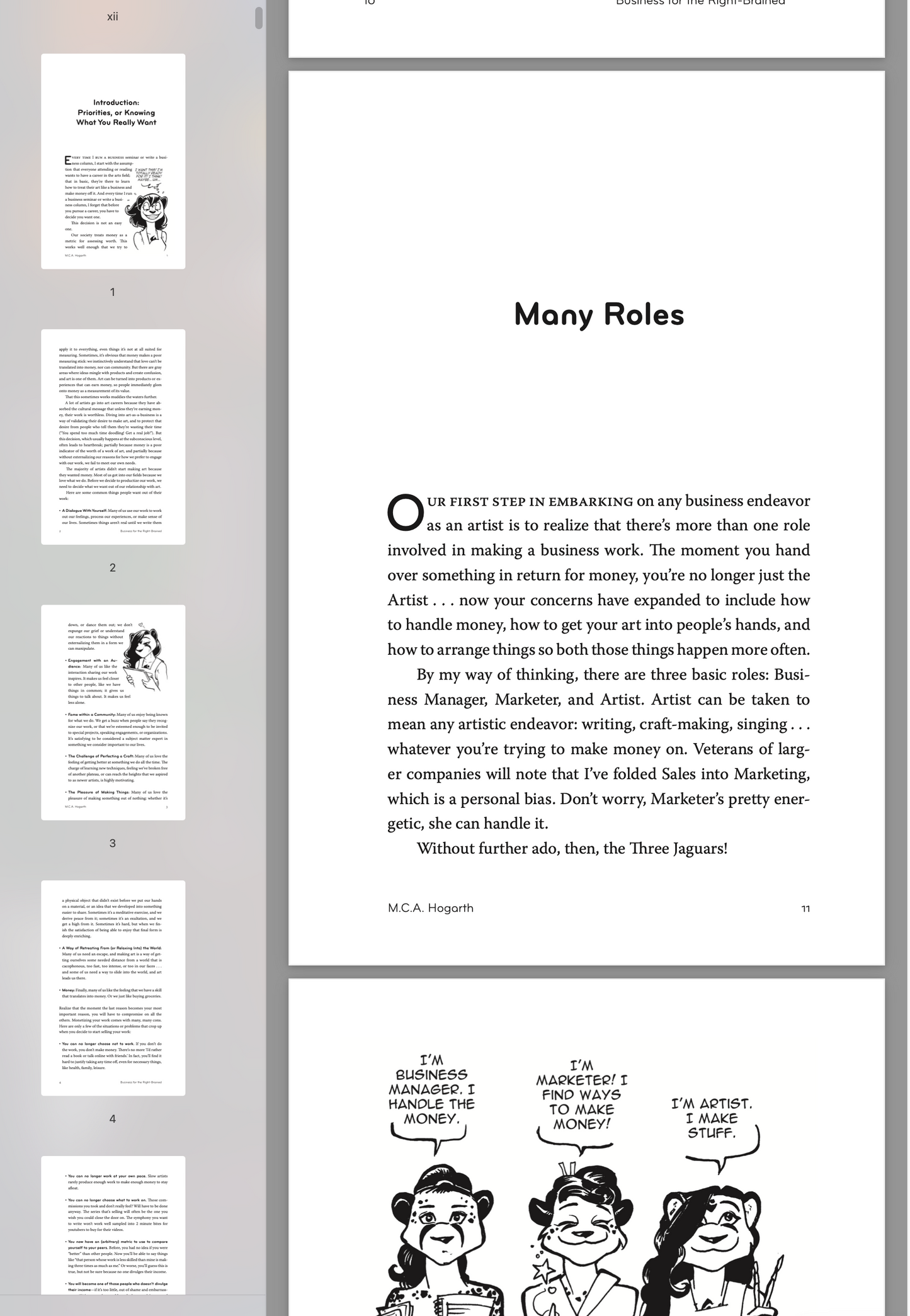Business for the Right-Brained: A Guide for Artists, Writers, Musicians, Dancers, Crafters, and All the Other Dreamers
Business for the Right-Brained: A Guide for Artists, Writers, Musicians, Dancers, Crafters, and All the Other Dreamers
Couldn't load pickup availability
Ebook delivered via email immediately!
A career as a freelance artist? Not possible, you say? The Three Jaguars beg to differ! In this cartoon and checklist-filled guide, Marketer, Business Manager, and Artist walk you through the challenges of starting and building a creative business. Topics include productizing your work; metrics and tracking; communication and networking strategies; Day Job wrangling; pricing; branding; and even how to market yourself without feeling (*shudder*) slimy! If you’ve been looking for a clear (and humorous!) guide to the philosophy and practicalities of being a professional artist… this is your book. Also, did I mention the cartoons?
Topic: business nonfiction
Tags: cartoon jaguars, humor, basic business principles, educational
Table of Contents
- Many Roles
- Products
- Know Thyself (and Have a Plan)
- The Day Job
- Metrics, Part 1: Tracking
- Metrics, Part 2: Trending
- What I Wish Someone Had Told Me When I Graduated College
- Enlisting the Aid of Your Inner Customer
- Time Management
- Un-Slimy Marketing
- Agility
- Pricing (or, the 99-Cent Ebook)
- Communication
- Brand
Excerpt from the Introduction
Monetizing your work comes with many, many cons. Here are only a few of the situations or problems that crop up when you decide to start selling your work:
You can no longer choose not to work. If you don’t do the work, you don’t make money. There’s no more ‘I’d rather read a book or talk online with friends.’ In fact, you’ll find it hard to justify taking any time off, even for necessary things, like health, family, leisure.
You can no longer work at your own pace. Slow artists rarely produce enough work to make enough money to stay afloat.
You can no longer choose what to work on. Those commissions you took and don’t really feel? Will have to be done anyway. The series that’s selling will often be the one you wish you could close the door on. The symphony you want to write won’t work well sampled into 2 minute bites for youtubers to buy for their videos.
You now have an (arbitrary) metric to use to compare yourself to your peers. Before, you had no idea if you were “better” than other people. Now you’ll be able to say things like “that person whose work is less skilled than mine is making three times as much as me.” Or worse, you’ll guess this is true, but not be sure because no one divulges their income.
You will become one of those people who doesn’t divulge their income—if it’s too little, out of shame and embarrassment; if it’s too much, out of fear of other people’s envy and anger; if it seems enough, out of worry that it will inspire other people to share their incomes with you, and illuminate that you’re wrong about doing pretty well.
Your peers will begin thinking of you as competition. While this isn’t universally true, there is a reason why artists talk with such admiration about peers who build other artists up, rather than rip them down.
People will judge you more harshly based on your prices. When people buy things, they demand a lot more out of them. The moment you acquire customers rather than an audience, you will be obliged to give them value for their dollar… and you and your customers may disagree on whether you’ve done enough.
People will treat you as interchangeable with other similar artists. You will discover that many people shop based on price, and that you can be passed over in favor of someone cheaper without any heartache on their parts.
You will no longer be able to “be yourself” without consequences. The things you say, your political and religious beliefs, and your lifestyle will suddenly become pertinent to buyers, and they will make decisions based on those things. If you’re lucky, for you. But you won’t always—or even often—be lucky, which means you’ll have to decide how much of your “real” self you want to keep hidden.
You will have to keep track of every dollar you earn and spend. Tracking receipts never sounds too bad; tedious maybe, but not bad. But you will have to squirrel out all the hidden costs as well. Your con table is never “the table cost + the airfare + the hotel bill.” It’s also “how much food I ate, the Paypal/Square fees that took a percentage of every in-person sale, the in-state taxes, the fact that the time I spent there was time not spent doing new work,” etc, etc.
You will have to analyze your work, which might lead you to unpleasant discoveries. You might assume that something you thought would sell really well, and that seems to be selling really well, is actually a dud. Or the work you spent the longest on is the work that sells least well. (Or conversely, the quick commissions you thought were shoring up your income are, in fact, losing you money.) This extends into ways of working too: those conventions you think are so much fun might actually be so bad for your profitability that you might have to give them up.
You will no longer think of your work as a fun refuge; every time you do it, you will unavoidably begin thinking about whether it can earn you anything. You will also find yourself analyzing everyone else’s work too; many people say they lose the ability to enjoy art as an audience once they’ve started selling it.
Your work may not ever earn you enough money, and you will find yourself resenting it for not being enough. “It means so much to me; why doesn’t it matter to other people?” “Why do I work so hard, and yet never make enough?” “Why do I have this talent if it can’t even buy me a cheap loaf of bread?” “Why don’t people understand that art doesn’t come from nowhere?” “Why don’t they care enough about me to help me succeed?” The list of ways you can get angry about not succeeding are endless… and worst of all:
Your goalposts will move. When you first start out, your goals will be modest: “Make $10 this month.” But once you hit those goals, you won’t be satisfied. They’ll become “Make $100 a month,” and then “$1000 a month.” (Or 600 reviews, or 500 downloads, or 10,000 watchers, or 10 awards). For most people, there’s never a good enough.
These are just some of the ways going into business as an artist will affect your relationship with art. Consider that last carefully and compare it against the ways art feeds your soul. If what you need from your art doesn’t align with what you have to do to make money at it, you should seriously consider whether you want to pursue art as a business venture.
In no universe should you think of your decision not to pursue art as a business venture a failure. (In fact, in some circles, you’re a failure if you do pursue it as a business venture!) Money does not define your worth as an artist. It exists to put food on your table—that’s all. But once you get involved with it, the temptation to continually assess yourself by the one metric—money—will almost invariably overwhelm your ability to hold on to the more ephemeral or abstract reasons you love doing the work, and you will find it very hard not to find your world narrowing to ‘how much money has this earned for me today.’
If this is a burden you don’t want, don’t go there. It’s totally okay not to go there. Many amazing works of art have been produced by people who saved their art for after they were done with their money-making activities, and they were not less beautiful, worthy, or compelling because they were done in someone’s ‘spare time.’
So! Before you read any of these business columns, sit down and make a list of reasons why you make art, and what you get out of sharing it. Be honest! There are no wrong answers. Decide whether you can get what you need from your work without productizing it, or if in fact productizing it might poison the well for you altogether. Once you get your list, prioritize the results. Is it more important for you to explore your inner issues, or to share your work with an audience? Do you like the feeling of being known in a community more than you like existing as a small fish in a big pond, the way most of us must if we’re chasing remuneration?
Until you do this step, you will flounder your way through the business stuff, or worse, you will be miserable and not know why.
Many an artist has decided they’d rather make soy lattes than lose their sense of joy in their work, or feel beholden to deadlines or projects they don’t care about. You will not be a lesser artist for joining their ranks: you will be a happier one, and happier artists create better work, and often more work, and take more pleasure from it. Plus, it frees you to occasionally sell your work without the pressure of having to do it all the time. Remember: life is rarely a series of black and white choices. Deciding to sell your work as a hobbyist is as valid a choice as not selling it at all, or embarking on art as a career professional.
Turning your art into a career involves a great deal of back-breaking labor, frustration, and a persistent sense that you can’t control your own success (because you can’t; 100% of this business is luck, and the other 100% is working like a mule, and the two have no connection). The rewards can be worthwhile, but you can’t earn them without compromises.
It may be that you’re not sure whether you want to go the business route or not, and if so, I hope this book will illuminate enough of what’s entailed to allow you to make an educated decision. (Or it may be that you feel you have no choice, and that you need to make money somehow, at which point I hope this book helps you make the best of a bad situation.) But knowing what you need is paramount to keeping your soul intact. So figure that out now, and then, turn the page.
Share


Formats
- Ebook - In your choice of e-format (epub, mobi, etc). You'll receive an email from Bookfunnel, the ebook distributor, with download instructions.
- Audio - If this book has an audio format, it will be listed. Not all books have audio, however, and some series have incomplete audio editions. You'll receive an email from Bookfunnel, the audio distributor, with download instructions.
- Paperback - A print-on-demand paperback, this ships from the printer directly.
- Doodled Paperback - This paperback will be signed by the author, and have a doodle drawn on its half-title page! This personalized option will ship from the author and may take 1-2 months to reach you.


